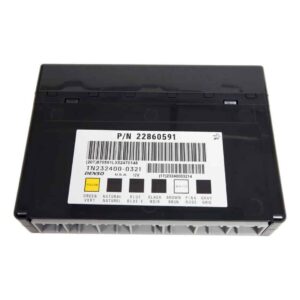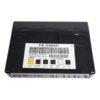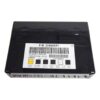Restore Your Truck’s Electrical Systems with a Reliable BCM
If you’re dealing with bizarre electrical problems in your 2010 Chevrolet Avalanche—like power windows with a mind of their own, flickering interior lights, or a security system that randomly acts up—you’re likely facing a failing Body Control Module (BCM). Think of the BCM as the central nervous system for your vehicle’s body electronics. When it malfunctions, it can cause a cascade of frustrating and seemingly unrelated issues. In my 20+ years as a technician, I’ve seen corroded BCMs cause intermittent no-start conditions that leave owners stranded and mechanics scratching their heads. It’s a common failure point, but thankfully, it’s a fixable one.
This isn’t just a replacement part; it’s a complete solution. We take the guesswork and high dealership costs out of the equation. Before we ship this module, we program it specifically to your truck’s Vehicle Identification Number (VIN). This ensures that it communicates perfectly with your vehicle’s other computers, retaining all the specific options and features your Avalanche came with from the factory. You get a BCM loaded with the latest GM software updates, ready for a straightforward installation, without the need for an expensive trip to the dealer for programming.
A Technician’s Notebook
I remember a 2010 Tahoe that came into the shop with the weirdest combination of symptoms: the radio would turn off when the left turn signal was used, and the dome lights wouldn’t work at all. The owner had already replaced the battery and checked all the fuses. A quick scan showed a dozen communication codes pointing towards the BCM. Water intrusion from a leaky windshield seal had corroded a few pins on the main connector. Swapping in a pre-programmed BCM like this one had the truck back to 100% normal in under an hour. It’s a textbook example of how a single module failure can create chaos.
Common Signs of a Failing BCM
- ✔ Erratic or non-functional power windows, door locks, and mirrors.
- ✔ Interior or exterior lights flickering, staying on, or not working at all.
- ✔ The security system or keyless entry failing to operate correctly.
- ✔ Warning lights on the dash, such as the airbag or ABS light, without a clear cause.
- ✔ Communication error codes, such as U0140, U0155, or other U-series codes, when scanned.
- ✔ Unexplained battery drain that kills the battery overnight.
Your Straightforward BCM Installation Guide
Replacing the 2010 Avalanche Body Control Module is a manageable job for a DIYer with basic tools. It’s typically located under the driver’s side of the dashboard.
- Safety First: Always disconnect the negative terminal from your vehicle’s battery and wait a few minutes to ensure all systems are powered down.
- Locate the BCM: On most GMT900 trucks like the Avalanche, the BCM is mounted to a bracket under the steering column, to the left of the brake pedal. You may need to remove a lower dash panel for access.
- Disconnect and Remove: Carefully unplug the multiple wiring harness connectors. They have locking tabs that need to be depressed. Once disconnected, unbolt the module from its mounting bracket.
- Install the New Module: Mount your new, pre-programmed BCM in the same location and securely reconnect all wiring harnesses. Make sure each connector clicks into place.
- Reconnect Power: Reattach the negative battery terminal.
- Perform Relearns: Start the vehicle. As noted in our technical information, you may need a capable scan tool to perform a ‘Setup SDM Primary Key in BCM’ if the airbag light is on, or a ‘Brake Pedal Position Relearn’ to ensure all safety systems are calibrated.
Solving the Problem with a Pre-Programmed Solution
The biggest hurdle in replacing a modern vehicle computer is the software. This 2010 Avalanche Body Control Module arrives with that problem already solved. By providing your VIN at checkout, you receive a module that is a direct physical and electronic match for your truck. This eliminates the need for expensive factory scan tools and subscriptions, saving you time and money and getting your vehicle back on the road faster. There’s no core charge, so you can keep your old part.
Will This Fit My Vehicle?
This BCM is a direct replacement for part number 20839063 and is compatible with a wide range of GM vehicles. It interchanges with numerous other part numbers, including 15892622, 20815898, 22860591, and more. It is confirmed to fit the following models, but please verify your part number or contact us with your VIN to ensure 100% compatibility:
- Chevrolet Avalanche 1500: 2010 (under steering column)
- Cadillac Escalade / ESV / EXT: 2010 (under steering column)
- Chevrolet Suburban 1500: 2010 (under steering column)
- Chevrolet Tahoe: 2010 (under steering column)
- GMC Yukon / Yukon XL 1500: 2010 (under steering column)
- Chevrolet Express & GMC Savana Vans: 2008-2012 (various engines)
- Chevrolet Impala: 2006-2013 (LH dash)
- GMC Acadia, Chevrolet Traverse, Buick Enclave, Saturn Outlook: 2007-2012 (LH dash)
- And many other GM cars, trucks, and SUVs as listed in the full fitment guide.
Frequently Asked Questions
Do I need to send my original BCM back?
No, there is no core charge for this part. You can keep your original module, which can be helpful for future reference if needed.
What information do you need to program the module?
We require your vehicle’s 17-digit Vehicle Identification Number (VIN) to program the BCM with the correct software and vehicle-specific options before shipping.
What is a BCM and what does it do?
The Body Control Module (BCM) is a computer that manages and controls many of your vehicle’s electronic accessories, such as power windows, lights, door locks, alarm system, and wiper functions.
Will I need special tools after installation?
In some cases, yes. If your airbag light comes on, a professional scan tool is needed to sync the airbag system. A brake pedal position relearn might also be necessary for certain models to ensure proper brake light and traction control operation.
Where is the BCM located on my 2010 Avalanche?
The BCM is typically located under the driver’s side dashboard, to the left of the steering column. You will likely need to remove a lower trim panel to access it.



